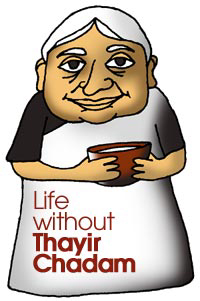
Pazhai chadam [the previous day's rice] and thayir [curd]," my Paati (grandmother) would always advise. Paati had everyone under her radar. No one could escape Thayir Chadam. It did not matter what time of the day it was, she made sure it was always available. My dad had it three times a day and mom had it several times, while my friends dreaded it! Paati, however, believed in it firmly.
My Paati was short, with salt and pepper hair and a face that was heavily lined. Despite having borne 11 children, there was nothing weak or feeble about her. Her face was a reflection of her inner strength. When she spoke, her words were strong and stern. She was orthodox and believed in following our customs and traditions. Paati rarely smiled but when she did, it conveyed the depth of her feeling. Her hands were strong, even though they now trembled with age. Her fingers had darkened with numerous tiny cuts and her palms were rough. These warm hands had worked hard; they had also wiped away many tears.
Paati could prepare Thayir Chadam in a jiffy. She would dip her hand in the leftover rice, which was always over-cooked for easy digestion, and pick a handful. This rice would then be mashed in another vessel before it was mixed with curd and water. Sometimes, the rice would be soaked in water overnight.
Years of experience had made Paati a Thayir Chadam expert. Thayir Chadam had various forms -- it could be solid, semi-solid or liquid depending on the urgency and the time of the day. Sometimes, it would be served with Vadugu Mangai (Spicy Mango Pickle) or the Red Bullet as I liked to call it. If you were in a hurry, she would mix it in equal proportions of water and call it Thayir Chadam Karaich. This was more popular than Coke in my home when Paati was around. The feeling of this salty mixture on a hot day could give beer a run for its money.
![]()
More exciting diaries!
![]()
![]()
![]()
![]()
Maybe it is better bald![]()
Ms Independent![]()
My friend's spineless husband![]()
![]()
![]()
She believed in the nutrition of her product and found no reason to explain what it did to the consumer.
The West has only recently realised the benefits of consuming curd. Scientists now believe the live bacteria in yoghurt are beneficial to health; they stimulate the human immune system as well as kill harmful bacteria. Yoghurt is widely known as an outstanding source of protein, calcium, potassium, phosphorus, vitamin B6, B12, niacin, folic acid and potassium. The US government has now set aside $ 90 million for the International Institute of Analysis and Research into Yoghurt and Allied Products. But our ancestors knew this 5,000 years ago when they settled down with their kamadhenus on the banks of the Vaigai and the Cauvery.
My fondness for Thayir Chadam increased as I grew older. Now that I am in the US, though, I have to compromise -- I am happy with thayir in any form if I cannot have the conventional Thayir Chadam. To me, a meal is not complete if there is no form of thayir to end it. So, every time I go out with my friends, I search for Raitha (chopped vegetables in curd) or any similar curd substitute.
No matter where in the world we Iyers wind up living, it is important for us to maintain our 'Iyer' identity -- to recognise it in each other and to share it with others.
One way we do this is by sharing our love of south Indian food. For many of us south Indian-Americans, our traditional foods have become our strongest metaphor for what it means to be an Indian. For me, Thayir Chadam, Idli Sambhar, Dosais, Adais and those wonderful Nai Appams I was raised on are a metaphor for so many things -- family, togetherness, warmth, a welcome to friends and neighbours and, yes, a welcome to strangers too.
To me, Thayir Chadam at the end of a hearty meal symbolises not only the oneness of the south Indian experience, but also our individual and regional preferences -- curd is never eaten in exactly the Iyer way in any other part of India. After these years of living in the US, my parents still remind us to have curd everyday and have passed on this tradition to our son.
My mother has now taken over the mantle from my grandmother. She makes Thayir Chadam in her own unique way, and her flavour is different from the ones made in other nearby homes. Any day you come to our home invited or uninvited, you can always tuck into a refreshing bowl of Thayir Chadam!
Illustration: Uttam Ghosh





